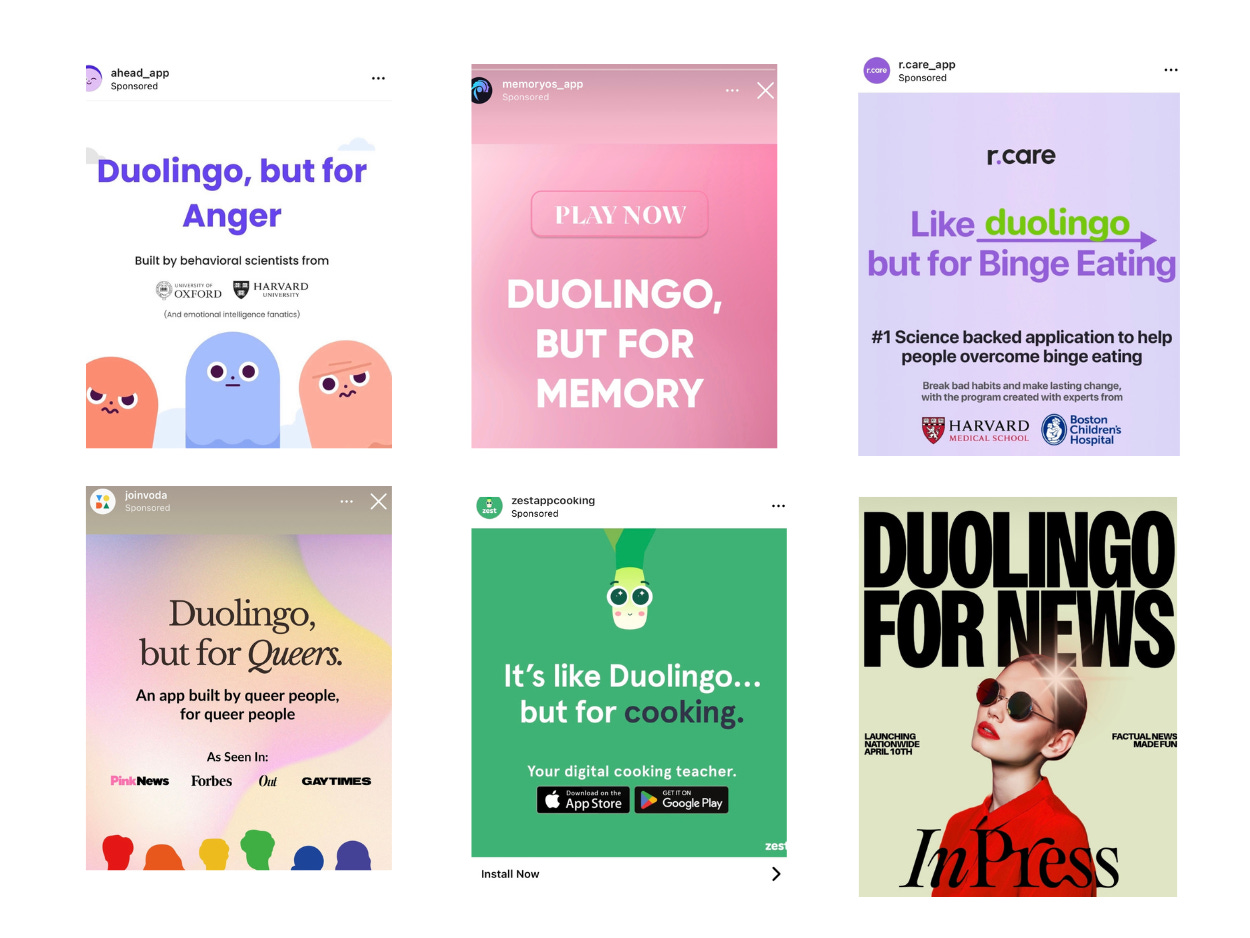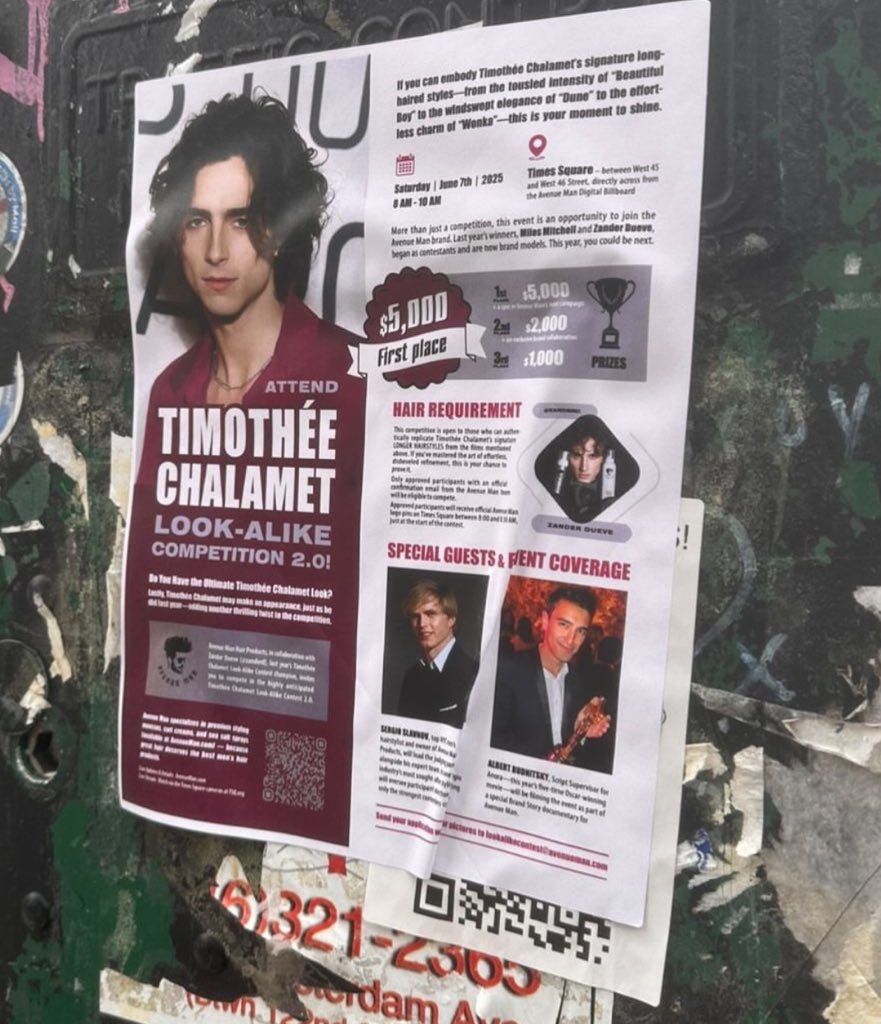Do we really need a Duolingo for everything?
Plus, a Timothée Chalamet look-alike contest 2.0?
About a year ago, I started noticing a pattern in the ads I was getting on my Instagram stories: apps were marketing themselves as the "Duolingo of" anything and everything—philosophy, cooking, binge eating, stress. I even saw ads for the "Duolingo for Ozempic" and the "Duolingo for queers" (huh?).
I went back and tested a few out.
I’ll start with Ahead, which I had seen advertised as "Duolingo for emotional intelligence"—as well as "Duolingo for" anger, heartbreak, therapy, and anxiety.
Described as a "personalized pocket coach that provides bite-sized, science-driven tools to boost emotional intelligence," the app onboards you with a short questionnaire about what you hope to improve and how much time you want to invest each day. You can then pick three "journeys," or areas to work on, like anxiety, confidence, and positivity.
Other apps have similar onboarding. R.care asks about your eating habits, what strategies you’ve tried in the past to reduce binge eating, your goals for using the app, and whether you have other conditions like anxiety or body dysmorphia.
While Voda—the "Duolingo, but for queers"—initially threw me off with the slogan, the app itself seems helpful and intentionally designed. It offers modules for building confidence, maintaining healthy relationships, and dealing with queerphobia.
While Voda, Ahead, and R.care all incorporate therapeutic skills and coping strategies, others focus on knowledge-building. Zest, for example, aims to help users develop their cooking skills in an accessible way, offering step-by-step breakdowns of different concepts and meals. Another app, Imprint—which I’m constantly getting ads for—has described itself as both "like Duolingo, but for finance" and "like Duolingo, but for philosophy."
Besides the catchy, sometimes nonsensical marketing, (which reminds me of how startups are often described as the Netflix or Uber of something), these apps reflect the trend of breaking down everything into bite-sized chunks, tailored for an audience used to getting information from multiple sources and formats. Apps like Blinkist summarize popular books, often in categories like business and self-help, into condensed summaries.
Summarization and aggregation are increasingly the name of the game when it comes to building a product delivering information—whether a cooking app or Substack newsletter.
A Timothée Chalamet look-alike contest 2.0?
While walking to get coffee this past week, I had to double back to snap a picture of something: a sign advertising the "Timothée Chalamet Look-Alike Competition 2.0."
"If you can embody Timothée Chalamet’s signature long-haired styles—from the tousled intensity of 'Beautiful Boy' to the windswept elegance of 'Dune' to the effortless charm of 'Wonka'—this is your moment to shine," the flyer reads.
Perhaps unsurprisingly, the contest is being held by a brand: Avenue Man Hair Products, in collaboration with Zander Dueve, who the flyer introduces as "Iast year’s Timothee Chalamet Look-Alike Contest champion" (Dueve came in second to Miles Mitchell).
"More than just a competition, this event is an opportunity to join the Avenue Man brand. Last year’s winners, Miles Mitchell and Zander Dueve, began as contestants and are now brand models. This year, you could be next," the flyer reads.
The flyer states the contest will be held on June 7 from 8 to 10 a.m. in Times Square. First prize is $5,000 and "a spot in Avenue Man’s next campaign." This information has also been posted on Avenue Man’s website.
In my view, the magic of the Timothée Chalamet look-alike contest 1.0 was its seeming spontaneity, having announced itself only through the appearance of badly designed posters around the city. In reporting on it, we learned that it was far from a spontaneous, low-budget production—but appearing as such was what mattered. Contestants soon spun their appearances in the contest into brand partnerships and other glamorous opportunities.
Given the overtly branded aspect of the 2.0 contest (and the fact that we may be all look-aliked-out by now), I doubt this will have quite the same turnout as the first. But I’m looking forward to seeing how it goes.




